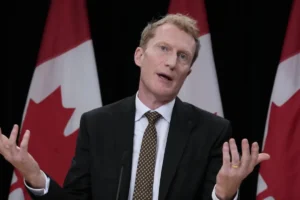
Powered by  Translate
Translate
Minister Defends Canada’s Immigration Targets: Prime Minister Justin Trudeau and Immigration Minister Marc Miller revealed the annual immigration targets for 2025-2027 that will reduce the intake of both temporary and permanent residents starting in 2025.
This change marks a major shift in Canada’s immigration policy following the post-pandemic surge, which was initially framed as a strategy to alleviate labour shortages and boost the economy.
However, the decision has sparked widespread conversations from migrant rights groups and business leaders, who argue the cuts unfairly target vulnerable populations and could harm the labour market.
In response to the criticism, Immigration Minister Marc Miller defends the new policy in an in-depth interview with CBC, explaining the government’s rationale and addressing concerns raised by advocacy groups and economists.
Below, we unpack Miller’s key remarks, reactions from stakeholders, and the broader implications of the immigration cuts.
Table of Contents
Marc Miller’s Rationale Behind the Immigration Cuts
Minister Miller emphasized that the decision to reduce immigration levels aims to ease pressures on housing and social services.
“There has been a lot of positive feedback from ordinary Canadians,” Miller said, framing the cuts as a “reasonable” step to address challenges related to population growth.
Miller argued that while immigration remains crucial for Canada’s future, uncontrolled migration is unsustainable.
He acknowledged the need for a “carefully managed” migration plan, noting, “Open borders and unlimited flow is absolutely not the solution.”
“We’ve built a plan that works for Canadians and offers a pathway for controlled migration,” Miller said. “This isn’t about trying to win votes—it’s about responsible governance.”
Backlash from Migrant Rights Advocates and Business Groups
Despite Miller’s assurances, migrant rights groups have strongly criticized the new policy, arguing that the cuts will harm vulnerable communities.
Hussain, a representative of the Migrant Rights Network, cautioned that politics rather than practical concerns are driving the policy change.
“One million people are at risk of being excluded from Canada just so the Prime Minister can boost his poll numbers,” said Hussain. “This isn’t about housing—it’s about shifting the political conversation.”
The backlash reflects broader fears that the immigration cuts may fuel anti-immigrant sentiment in Canada, similar to trends seen in the United States and the United Kingdom.
Some activists have accused the government of using immigrants as scapegoats for housing shortages and economic challenges, a sentiment Miller vehemently denied.
“Racism is not behind this decision,” Miller responded. “Our goal is to protect the immigration consensus we’ve built in Canada and ensure sustainable migration.”
Economic Concerns: A Delicate Balancing Act
Economists are also raising concerns that the reduction in immigration may lead to flatline economic growth.
Rebecca Young, an economist from Scotiabank, warned that last year’s immigration surge was “too hot” and this year’s cutback risks being “too cold.”
Economic immigration has always been a big contributor to the Canadian economy.
Miller acknowledged these concerns, noting that Canada’s immigration strategy must carefully balance economic needs with humanitarian goals.
“While we respect the viewpoints of economists,” Miller said, “immigration is about more than numbers. It also involves family reunification, supporting humanitarian efforts, and maintaining the vibrancy of Francophone communities outside Quebec.”
He also pointed out that Canada faces long-term demographic challenges, including an aging population and declining worker-to-retiree ratios.
“In 1973, the worker-to-retiree ratio was 7:1. Today, it’s closer to 3:1. We need to ensure that we have a younger workforce to sustain our social services.”
Business Leaders Question Workforce Impact
Minister Defends Canada’s Immigration Targets
The immigration cuts have also raised alarms among business groups, who fear that the reduction in temporary foreign workers will exacerbate labour shortages across key sectors.
“Where will businesses find workers if immigration levels are cut?” some business leaders have asked, expressing concern that the policy could disrupt economic recovery efforts.
Miller addressed these concerns, acknowledging that the government must continue to engage with stakeholders.
“We have been listening to economists, business groups, and advocacy organizations. However, the flow of immigration must remain manageable to avoid system overload and prevent abuses in the temporary residence stream.”
A Path Forward: Balancing Public Opinion and Policy
Miller emphasized that the immigration cuts reflect public sentiment gathered over the past year, with many Canadians expressing concerns about rapid population growth and its impact on housing.
However, he stressed the importance of maintaining constructive dialogue with those who disagree, including those with anti-immigration views.
“We need to engage with people who have different perspectives on immigration,” Miller said. “We can’t dismiss their concerns as racist, but we also can’t allow divisive rhetoric to take root.”
The minister concluded by reaffirming the government’s commitment to building a sustainable immigration system that balances economic, humanitarian, and social objectives.
“Canada remains one of the most desirable destinations in the world,” Miller noted. “Our challenge is to ensure that our immigration system reflects both the country’s needs and its values.”
What’s Next?
The federal government’s immigration strategy is likely to remain a hot topic in the coming months, with opposition parties and advocacy groups expected to keep pressure on the Trudeau administration.
As the government moves forward with the revised immigration levels plan, key questions remain:
- How will the policy impact the economy and labour shortages across industries?
- Will the government introduce new measures to support immigrants affected by the cuts?
- How will the public respond to the long-term economic impact of reduced immigration?
The Trudeau government’s decision marks a pivotal moment in Canada’s immigration policy.
Whether the plan achieves its intended goals or deepens political divides will become clearer in the months ahead.
GFK Immigration
Gboyega Esan RCIC R708591
Phone: +1 (647) 225-0092
#Canada #Jobs #foreignworkers #daylight #DST #PR #StudyPermit #CanadaImmigration #PostGraduateOpportunities #GFKImmigration #StayInCanada #Express #ExpressEntry #draws #Immigration
